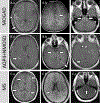Cerebral enhancement in MOG antibody-associated disease
- PMID: 37221051
- PMCID: PMC10679850
- DOI: 10.1136/jnnp-2023-331137
Cerebral enhancement in MOG antibody-associated disease
Abstract
Introduction: Limited data exist on brain MRI enhancement in myelin-oligodendrocyte-glycoprotein (MOG) antibody-associated disease (MOGAD) and differences from aquaporin-4-IgG-positive-neuromyelitis-optica-spectrum-disorder (AQP4+NMOSD), and multiple sclerosis (MS).
Methods: In this retrospective observational study, we identified 122 Mayo Clinic MOGAD patients (1 January 1996-1 July 2020) with cerebral attacks. We explored enhancement patterns using a discovery set (n=41). We assessed enhancement frequency and Expanded Disability Status Scale scores at nadir and follow-up in the remainder (n=81). Two raters assessed T1-weighted-postgadolinium MRIs (1.5T/3T) for enhancement patterns in MOGAD, AQP4+NMOSD (n=14) and MS (n=26). Inter-rater agreement was assessed. Leptomeningeal enhancement clinical correlates were analysed.
Results: Enhancement occurred in 59/81 (73%) MOGAD cerebral attacks but did not influence outcome. Enhancement was often patchy/heterogeneous in MOGAD (33/59 (56%)), AQP4+NMOSD (9/14 (64%); p=0.57) and MS (16/26 (62%); p=0.63). Leptomeningeal enhancement favoured MOGAD (27/59 (46%)) over AQP4+NMOSD (1/14 (7%); p=0.01) and MS (1/26 (4%); p<0.001) with headache, fever and seizures frequent clinical correlates. Ring enhancement favoured MS (8/26 (31%); p=0.006) over MOGAD (4/59 (7%)). Linear ependymal enhancement was unique to AQP4+NMOSD (2/14 (14%)) and persistent enhancement (>3 months) was rare (0%-8%) across all groups. Inter-rater agreement for enhancement patterns was moderate.
Conclusions: Enhancement is common with MOGAD cerebral attacks and often has a non-specific patchy appearance and rarely persists beyond 3 months. Leptomeningeal enhancement favours MOGAD over AQP4+NMOSD and MS.
Keywords: MRI; MULTIPLE SCLEROSIS; NEUROIMMUNOLOGY.
© Author(s) (or their employer(s)) 2024. No commercial re-use. See rights and permissions. Published by BMJ.
Conflict of interest statement
Competing interests: PE has no conflicts of interests or financial disclosures to declare regarding this submission. LC received speaker and consultant honoraria from Biomedia, ACCMED, Roche, BMS Celgene and Sanofi. KNK and DG reports no disclosures. JJC has received consulting fees from Roche, UCB and Horizon. ASL-C has served on advisory boards for Genentech and Horizon Therapeutics. ES, VR and PPM reports no disclosures. JLC has received research support from Roche and Genentech for an MS clinical trial, and serves as chair of the DMSC for several migraine clinical trials. DMW has received consulting fees from Alexion, Roche, Genentech, Horizon Therapeutics, Imcyse, Bristol Myers Squibb and Reistone, serves on an attack adjudication committee for a MOGAD clinical trial funded by UCB Pharma and is co-editor in chief of the neurologist. J-MT is associate editor for Journal of Child Neurology. CV-S and ST no disclosures. SJP reports grants, personal fees and non-financial support from Alexion Pharmaceuticals; grants, personal fees, non-financial support and other support from MedImmune, Inc/Viela Bio.; personal fees for consulting from Genentech/Roche. He has a patent, Patent# 8889102 (application#12-678350, Neuromyelitis Optica Autoantibodies as a Marker for Neoplasia)—issued; a patent, Patent# 9891219B2 (application#12-573942, Methods for Treating Neuromyelitis Optica (NMO) by Administration of Eculizumab to an individual that is Aquaporin-4 (AQP4)-IgG Autoantibody positive)—issued. EPF has served on advisory boards for Alexion, Genentech, Horizon Therapeutics and UCB. He has received research support from UCB. He has received speaker honoraria from Pharmacy Times. He received royalties from UpToDate. EPF was a site primary investigator in a randomised clinical trial on Inebilizumab in neuromyelitis optica spectrum disorder run by Medimmune/Viela-Bio/Horizon Therapeutics. EPF has received funding from the NIH (R01NS113828). EPF is a member of the medical advisory board of the MOG project. EPF is an editorial board member of the Journal of the Neurological Sciences and Neuroimmunology Reports. A patent has been submitted on DACH1-IgG as a biomarker of paraneoplastic autoimmunity.
Figures

References
-
- Banwell B, Bennett JL, Marignier R, et al. Diagnosis of myelin oligodendrocyte glycoprotein antibody-associated disease: International MOGAD Panel proposed criteria. Lancet Neurol 2023;22:268–282. - PubMed
-
- Banker P, Sonni S, Kister I, Loh JP, Lui YW. Pencil-thin ependymal enhancement in neuromyelitis optica spectrum disorders. Mult Scler 2012;18:1050–1053. - PubMed
-
- Ito S, Mori M, Makino T, Hayakawa S, Kuwabara S. “Cloud-like enhancement” is a magnetic resonance imaging abnormality specific to neuromyelitis optica. Ann Neurol 2009;66:425–428. - PubMed
-
- Pittock SJ, Lennon VA, Krecke K, Wingerchuk DM, Lucchinetti CF, Weinshenker BG. Brain abnormalities in neuromyelitis optica. Arch Neurol 2006;63:390–396. - PubMed
Publication types
MeSH terms
Substances
Grants and funding
LinkOut - more resources
Full Text Sources
Medical
